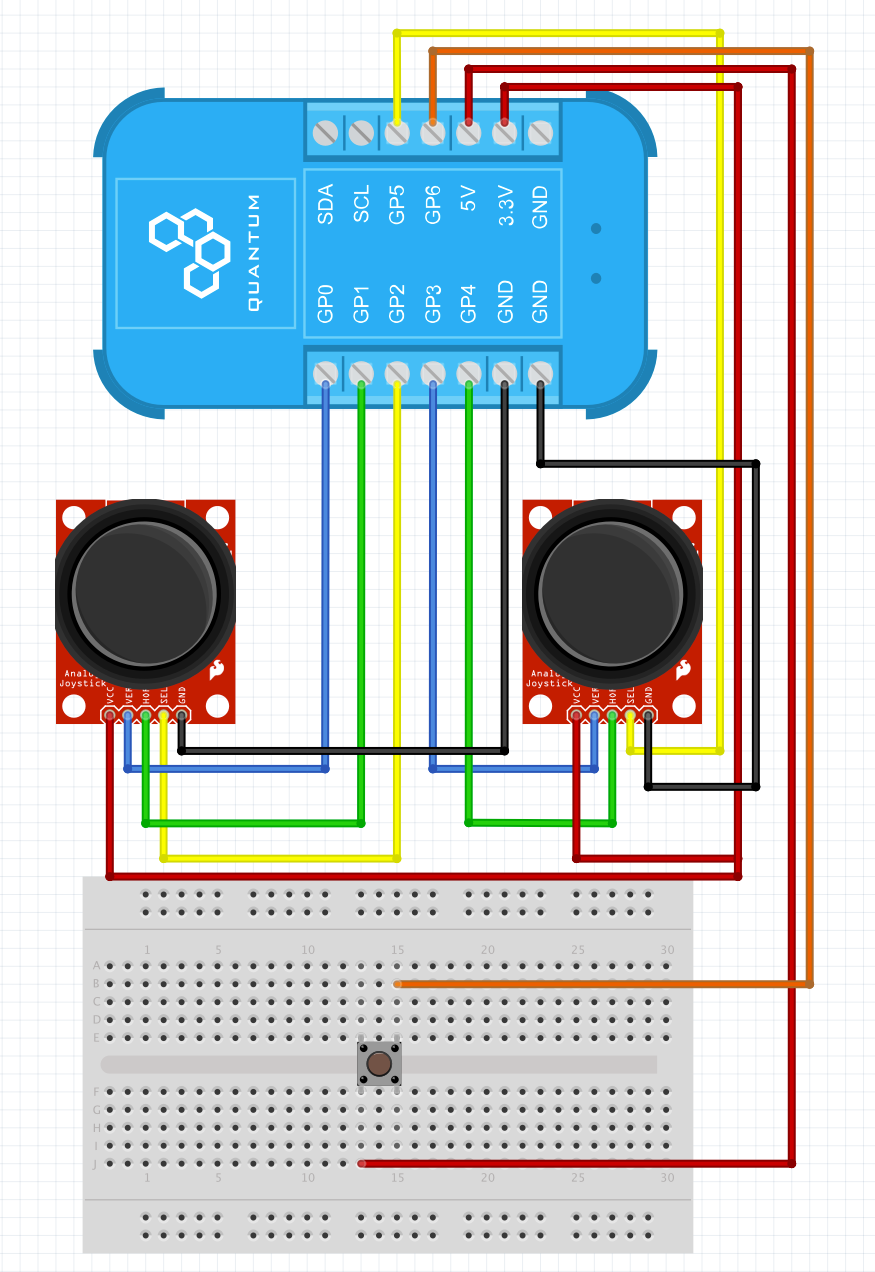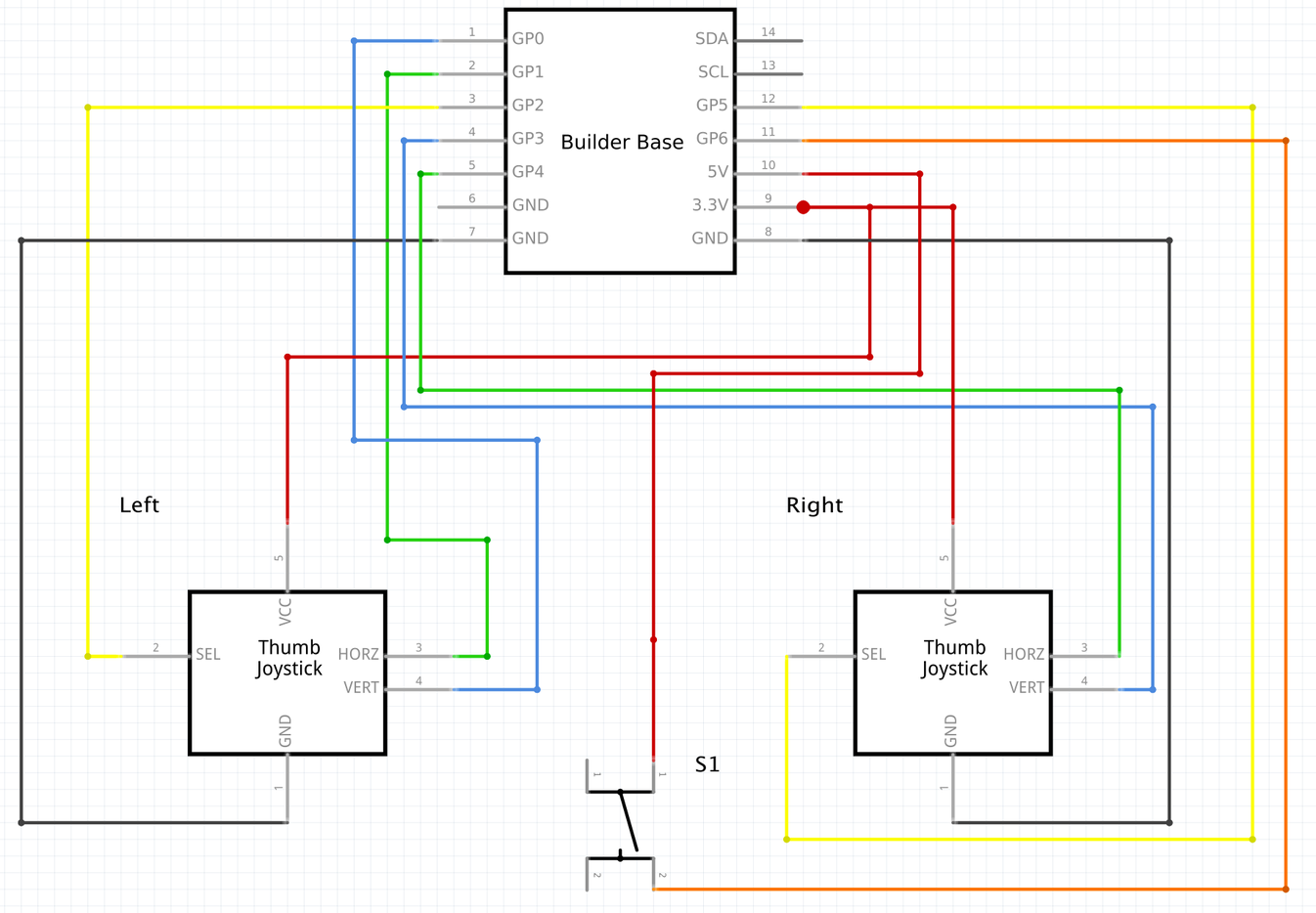This project is intended to show one how to setup a joystick with their Quantum platform. It’s an easy project that can be utilized to control numerous motor driven projects.
VideoProcedureStep 1: Assemble the HardwareTo get started, gather all of the parts listed above.
Take your two joysticks and connect a male to female jumper wire to every terminal on them. Like so:
Now, on your bread board place the tactile push button and attach a MM jumper wire to one pin and another MM wire to the pin diagonal to that one, like so:
Finally, follow the schematic and bread board diagrams below to attach the components to the Builder Base:
***Be careful to connect both Joysticks to 3.3V and not 5V! If you don’t your readings will be wrong.
Step 2: Build the FirmwareNavigate to the Firmware Builder and create a new Firmware file. We named ours Joystick.
Next, click the “+ Add Hardware” button and find the Joystick device via the search bar, select it, name it, and then click “Add Hardware”. We named ours Left.
Now, add another device by clicking the “Add Hardware” button again, and add another Joystick. We named this one “Right”.
Lastly, we will add one more device. Repeat the steps above to add another device, but this time search for a “Button”.
You should now have three devices in your firmware file.
Now you can follow this video to configure each device in the firmware file:
Now you can upload your firmware to the Build Base.
Navigate to the Applications page and click the “+ Create New Button”, name your application, and click create.
You will now be directed to the App Builder Canvas.
Using the search bar in the left hand tool-bar search for the Joystick code object and drag it onto the canvas.
We will now name the Joystick code objects by clicking on them and editing their name in the right hand “properties” panel.
Search for a “Button” hardware object, drag it onto the canvas, and name it accordingly.
In order to save the names you must click the “Save Properties” button at the bottom of the properties tab.
Next, search for the “Slider Analog” code object using the search bar and drag four of them onto the canvas.
Search for the “Switch” object and drag three of them onto the screen.
At this point you should name and label all of your interface objects (The Switches and the Analog Sliders), as this will make them easier to identify on the dashboard.
We’ll show you how to do the first one. Select the object you wish to change the name of by clicking on it. The properties panel on the right will pop open. Here you can change the “Object Name” and the “Label”.
For this first object we will change both the Label and the Object Name to “X-Axis Left Joystick”. Remember to hit the “Save Properties” tab for each object that you rename, otherwise your changes will be lost.
Now that each of your interface objects are properly labeled, let’s connect the Hardware objects to them. Connect the objects as follows:
Your application is now complete! Save it and return to the Applications page.
Step 4: Map Your ApplicationYou should now be back on the Apps page.
Find your “Joystick” app and hit the play button.
A list containing all of the devices in your application will expand.
Next click on the “Button” device and the client dropdown menu will appear on the right.
Select the Button driver from the dropdown menu and hit “Done”.
Repeat the same steps for the “Right” and “Left” Joystick devices.
Notice how the status symbols have changed to green checkmarks.
**When mapping firmware devices to objects in your Apps it is important to note that only devices and objects of the same type can be mapped together. Using this app for example, we are only given the option to map the client with the button firmware to the button object.
Step 5: Run the Application!Lastly, hit “Save + Run”
Congratulations! Your Joystick project is now complete! You can now use this as input control for RC cars and other motorized projects!
Links:
For more information about this project, check out our Joystick Controller Project Info Page
For more information about Quantum as well as any resources needed, check out our Website







Comments